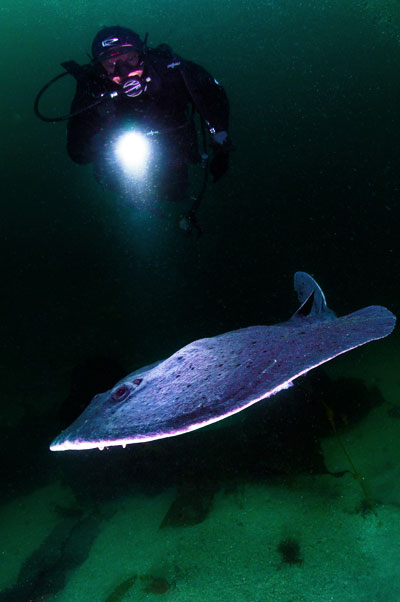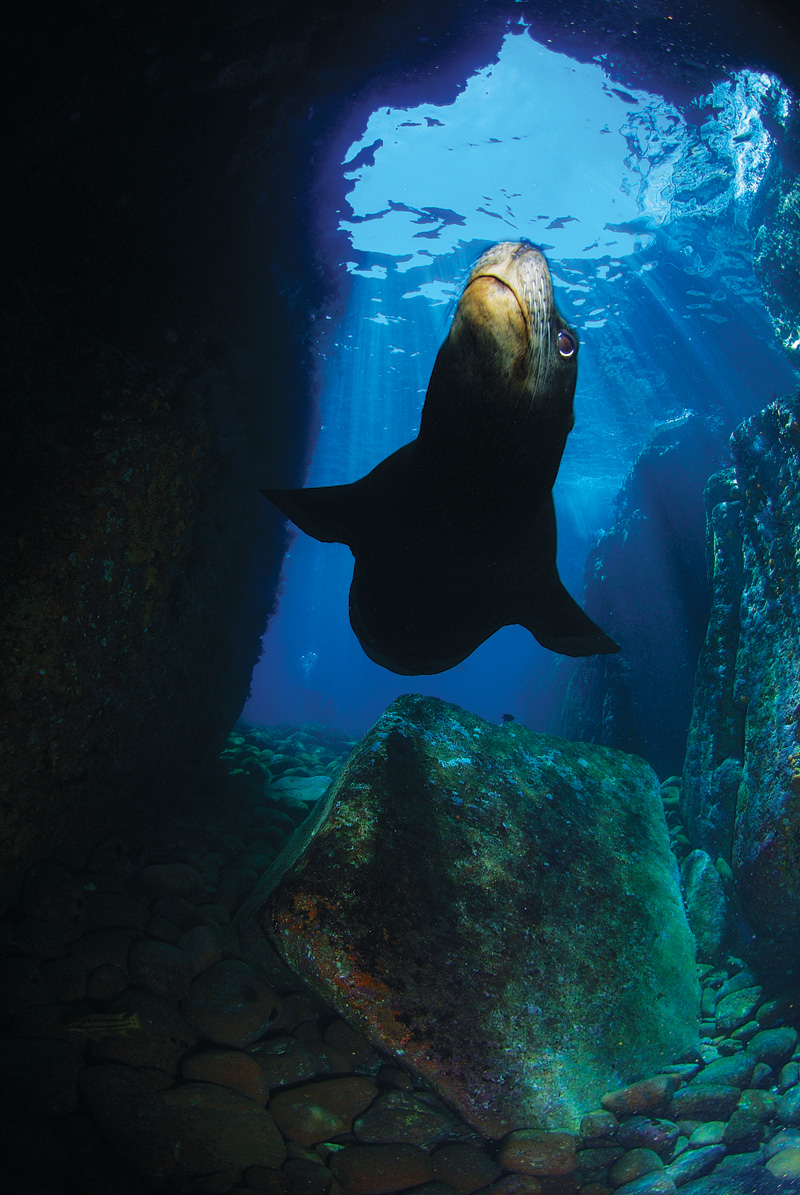Animal encounters can happen at anytime during a dive, and can leave life-long impressions. The encounter can occur in a flash or last an entire dive. As profound as the experience can be, it is often missed by our dive buddy swimming right next to us. My very first overhead fly-by of a batray occurred just like that. I saw the ray through the kelp, banking and heading directly towards my position. My buddy, just out of arms reach, couldn’t hear my fervent shouting. Afraid of moving and scaring the oncoming ray, I slowly raised my little 3 megapixel camera and waited for it. My buddy finally turned around, angered by my fin tugs, but the bat ray had already smiled upon me and kept on moving.

Animal encounters are like that in the ocean. Some people seem to be “fish whisperers,” but for the rest of us, trying to photograph these animal encounters can be frustrating at best.
Here are a few of the techniques that I have discovered or learned along the way to improve my chances of getting closer to the critters, and shooting their photos.
First, researching your subject a bit before going into the water will help you to understand the animal, its habitats, and habits. Learning anything about the animal beforehand is exponentially better that not knowing anything at all. You can also reference other photos online of the animal to read other photographer’s stories on how they successfully captured the shot.
Time in the water seems like an obvious point. The more time I spend in the water the greater the chances will be that I have a marine animal encounter. Slow dives can change in a flash when an encounter begins to unfold, so be ready with your camera and try to get the shot.
After many fruitless dives of trying to get close to our Giant Black Seabass in Catalina, a friend suggested that I try something different. That is when I learned to change my approach.
Approach is everything. Quietly and slowly move towards your subject to eliminate the water between you. It works best for me when I lead with the shoulder first, sideways if I can. If the animal is a player, then it will stick around; if not, then the animal will stress and bolt away. Try not to make direct eye contact as this is a show of aggression, and the fish now sees you, the approaching big black blob, as hostile.
Waiting for the animal is a great way to improve your chances of having a positive interaction. Chasing them never works, and will only produce a fish butt photo. Instead, try waiting for them to relax and come to you. Sea lions are playful enough, but if you have ever played chase with a harbor seal, then you know how frustrating it can be. Harbor seals love to pull on your fins, tug on your mask strap, and even nudge your arm; but as soon as you turn around, they disappear in a flash.
Next time, try waiting for the boisterous seal to come to you; often a game of hide and seek will lead to an incredible experience.
Anticipating an encounter before a dive can also help you to be prepared. Discuss the site and the plan with your buddy, and set your camera up so it’s ready to go. Be sure there is some working space between you and your buddy and hunt your subject together. Once the animal has been engaged, relax and try to work with it.
Almost every dive site has resident animals that frequent the site at different times of the year. Many sites in Southern California have a reliable variety of subjects to choose from. The Torpedo ray in this shot isn’t an accidental photograph. My buddy and I discussed the encounter, talked about the photo we wanted to capture, and then left the rest to chance. Torpedo Rays (California Electric Ray) are generally found a bit deeper than other rays in our waters, and will hover above the sand, hunting. They can often be aggressive and charge when agitated. Keep an eye on your subject so undue stress can be avoided. Working with my buddy up slope and slowly drifting along helped us to reduce our regulator noise
Animal encounters are as unique as the critters; if the animal is relaxed, then it will go about its own business, letting you see a little of its natural behavior. Remember these three things: approach gently, don’t harass, and relax. Let the animal feel you’re relaxed in the water, and it will feel the same way.
_______________________________________________________________________________
Words & Photos by Mike Bartick
Visit Mike’s website at SaltwaterPhoto.com
_______________________________________________________________________________

